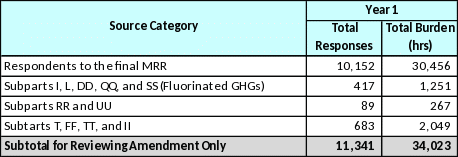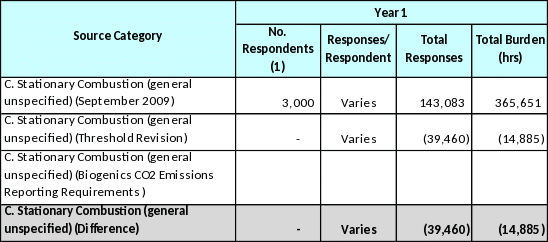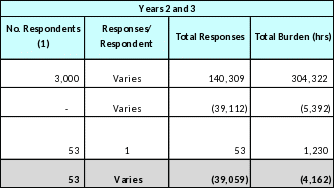2300j06
2300j06.docx
Regulation to Establish Mandatory Reporting of Greenhouse Gases (Reconsideration Package)
2300j06
OMB: 2060-0629
Regulation to Establish Mandatory Reporting of Greenhouse Gases
Reconsideration Package
OMB Control Number 2060-0629, EPA ICR Number 2300.06
On October 30, 2009, EPA promulgated the final rule titled: Mandatory Reporting of Greenhouse Gases (74 FR 56259), under the authority of Sections 114 and 208 of the Clean Air Act. The final rule (Part 98) requires reporting of greenhouse gas (GHG) emissions and other relevant information from certain sources in the economy. Data collection begins in the 2010 calendar year with the first reports submitted by March 31, 2011, and annually thereafter by that deadline.
Following publication of the rule, EPA has been working closely with owners and operators of facilities subject to the rule to communicate reporting requirements. Through these discussions, EPA has identified specific sections of the final rule that were either not clear, or did not have the intended effect. EPA is amending specific provisions in the GHG rule to resolve issues and questions raised during implementation, and to correct technical and editorial errors that have been identified since publication. This memorandum documents changes in the national respondent burden estimates associated with the revisions.
Additional First-Year Burden Associated with the Review of Revisions Provisions
During the first year of the GHG Reporting Program (GHGRP), EPA anticipates all reporting facilities would need to review the amended provisions associated with the notice of revisions. To estimate these costs, EPA assumes an additional 3-hour burden to review the revisions provision. Multiplying the additional burden by the estimated affected population, the total additional first year burden is estimated to be 34,023 hours.
Table 1. First Year Changes Associated with Review of Revisions Provisions (hours)

Subpart NN: Local natural gas distribution companies (LDCs)
EPA is amending Part 98 to require all LDCs that deliver 460,000 thousand standard cubic feet (mscf) or more of natural gas per year to be required to report. EPA is setting this capacity-based threshold because a capacity-based threshold would be more familiar to LDCs. Owners and operators of LDCs know how much natural gas they deliver to their customers and it would, therefore, be easier for facilities to determine if they are subject to the rule, than if the threshold were emissions-based. The threshold is approximately equivalent to 25,000 mtCO2e.
Under the new reporting threshold, the number of covered LDCs falls by 848 facilities. EPA estimates the revised total respondent burden to decrease by 63,048 hours in the first year and 46,766 hours in the second and third years (see Tables 2a and 2b).
Table 2a. First Year Change in Burden Associated with Modifications to Subpart NN (hours)
(1) Total number of respondents reflects the net change anticipated by these revisions.

Table 2b. Second and Third Year Change in Burden Associated with Modifications to Subpart NN (hours)

(1) Total number of respondents reflects the net change anticipated by these revisions.
Subpart C: Tier 4 Requirements for Units that Combust Greater than 250 Tons of Municipal Solid Waste (MSW) per Day
Threshold Revisions
In Part 98, EPA finalized a threshold of 250 tons per day of MSW, along with the requisite monitors to determine who had to follow Tier 4, versus who could use Tier 2. EPA is amending Part 98 to change the 250 tons per day threshold to 600 tons per day, based on EPA analysis that this value is approximately equivalent to the 250 mmBtu/hr heat input requirements for other large stationary combustion units (please see the Background Technical Support Document for Revisions EPA-HQ-OAR-2008-0508). Units that do not meet the 600 tons per day trigger, and do not have the requisite monitors, could use Tier 2. EPA believes that this revision still meets the desired goal to obtain high quality data from larger units, while not applying unnecessary burden. With this revision, general stationary combustion units will be subject to similar thresholds and conditions.
Under the new reporting threshold, EPA believes 87 general unspecified industrial combustion units will move from Tier 4 to Tier 2. EPA estimates the revised total respondent burden to decrease by 14,885 hours in the first year and 4,162 hours in the second and third years (see Tables 3a and 3b).
New Biogenics CO2 Emissions Reporting Requirements
Under the proposed rule, EPA was trying to reflect in regulatory language clarifications that have been issued stating that separate reporting of biogenic emissions for units subject to 40 CFR part 75 was optional. To clarify this optional reporting, EPA proposed to amend the data elements in subpart A (specifically §98.3(c)(4)) and subpart C that currently require separate accounting and reporting of biogenic CO2 emissions so that it is optional for Part 75 units. All units, except Part 75 units, would still have been required to calculate and report biogenic CO2 emissions separately under subpart C.
EPA received numerous adverse comments on the proposed amendments that would re-structure §98.3(c)(4) and make separate reporting of biogenic CO2 emissions optional for Part 75 units. Most commenters urged EPA to make separate reporting of biogenic emissions mandatory for all reporters. Based on the comments received, EPA decided to withdraw the proposed re-structuring of §98.3(c)(4). EPA also reconsidered their position on optional biogenic CO2 emissions reporting for Part 75 units. In the final rule, a new paragraph, (c)(12), has been added to §98.3(c), which states that this reporting is optional only for the first year of the program (i.e., for the 2010 reporting year). Thereafter, all Part 75 units must separately report their biogenic CO2 emissions. EPA is allowing the optional biogenic CO2 emissions reporting for the 2010 reporting year in light of previous statements and guidance on the issue. It is likely that at least some Part 75 sources are following that policy guidance and have elected not to separately report biogenic CO2 emissions. It is equally likely that these sources have not been keeping the necessary records or performing the required emission testing to enable them to report these emissions for 2010.
Table 3a. First Year Change in Burden Associated with Modifications to Subpart C (hours)

(1) Total number of respondents reflects the net change anticipated by these revisions.
Table 3b. Second and Third Year Change in Burden Associated with Modifications to Subpart C (hours)

(1) Total number of respondents reflects the net change anticipated by these revisions.
Summary Respondent Burden Changes Associated with the Notice of Revisions
National respondent burden estimates are presented in Table 4. EPA estimates that the revised annual average national burden to all affected entities reflects a net reduction in burden of 48,589 hours and $3.6 million.
Table 4. Summary of Change in Burden and Cost Associated with the Notice of Revision
Source Category |
Annual Average - 3 year ICR Period |
|
|
|
|
|||||||
No. Respondents |
Responses/ |
Total Responses |
Total Burden (hrs) |
Labor Cost |
Capital Cost |
O&M Cost |
Total Cost |
|
|
|
|
|
C. Stationary Combustion (general unspecified) (Total Difference) |
35 |
Varies |
(39,193) |
(7,736) |
-$409,238 |
-$347,655 |
-$724,256 |
-$1,481,149 |
|
|
|
|
NN. Supplies of Nat Gas and Nat Gas Liquids (Difference) |
(848) |
Varies |
(72,928) |
(52,194) |
-$2,927,013 |
$0 |
$0 |
-$2,927,013 |
|
|
|
|
Subtotal for Reviewing Amendment Only |
3,780 |
1 |
3,780 |
11,341 |
$805,211 |
$0 |
$0 |
$805,211 |
|
|
|
|
|
|
|
|
|
|
|
|
|
|
|
|
|
TOTAL (Change in Burden)* |
(848) |
Varies |
(108,340.3) |
(48,589.0) |
-$2,531,041 |
-$347,655 |
-$724,256 |
-$3,602,952 |
|
|
|
|
* Total number of respondents reflects the net change anticipated by these revisions. |
|
|
|
|
||||||||
Other Amendments in Notice of Revisions
EPA is revising several other provisions in Part 98. EPA has estimated that on the whole, these revisions do not change the overall respondent burden of Part 98. The other revisions could be categorized as follows:
Revisions to provide additional flexibility for reporters based on questions raised during implementation.
Revisions that clarify existing data reporting requirements.
Revisions that require facilities to report basic facility ID information that they already know.
Revisions that require reporters to report a data element for which there was a general recordkeeping requirement, but was not previously required to be reported.
Revisions that require reporting of the results of certain calculations in Part 98 for which calculation was previously required, but reporting was not.
Renumbering of data reporting elements in most subparts.
See Appendix 1 for an elaboration on each of these changes and examples from the revisions.
Appendix 1: Categories of Revisions That Do Not Affect Burden
Clarification of existing data reporting requirements: There is currently a data reporting requirement in Part 98. However, based on perceived confusion among reporters, EPA is providing additional clarity on what was intended. There is no change in burden from these revisions.
Requirement |
Change in Data Reporting Elements |
Subpart G: 98.76(b)(6) requires reporters to report the sampling results of carbon content of petroleum coke as determined for QA/QC of supplier data.
|
The data reporting element is amended to clarify that the reporting element applies to feedstock, this may be petroleum coke, but there are also other potential feedstocks. |
Subpart C: 98.36(d)(1) requires that for stationary combustion units that either are subject to the Acid Rain Program or not in the Acid Rain Program but monitor and report CO2 mass emissions year-round according to 40 CFR part 75, reporters report certain unit level information.
|
The data reporting element is amended to clarify that the reporting element applies to units subject to subpart D, which is a more simplified way of stating who the provision covers. |
Proposed rule provides additional flexibility for reporters based on questions raised during implementation. With the additional flexibility comes additional data reporting requirements, including identifying which approach the reporter is taking and any new data reporting elements associated with the new approach. Because the new approach is an option there is no increase in burden associated with implementing the option because reporters are not required to do so.
Requirement |
Change in Data Reporting Elements |
Subpart C- 98.36(e)(2)- previous rule required facilities subject to use default HHVs found in Table C-1. We propose to provide additional flexibility to use site-specific HHVs. |
- New data reporting requirements to clarify that when you use a site-specific HHV, you must also report that HHV value. |
Subpart X- 98.243(c) (5)(i) – add the option to use standard conditions for the molar volume conversion of either: 849.5 scf per kg-mole at 68 °F and 14.7 PSIA or 836.6 scf/kg-mole at 60 °F and 14.7 PSIA). |
- New data reporting element: report standard temperature at which gaseous feedstock and products volumes used were determined. |
Subpart X- 98.246(a)- allow use of alternative methods than those listed under limited circumstances. The burden analysis estimated that they had to follow a method and indicate which method they used. |
- New data reporting element to report/provide the: name or title of analystical method, copy of the method and explanation of why alternative is needed. |
Subpart Y – 98.253(b)(1)(ii)(A) – add the option to calculate CO2 emissions from flares using a different equation. |
- New data reporting elements: the inputs to the new equation (e.g., the number of carbon containing compounds other than CO2 in the flare gas stream) |
Subpart Y: 98.253(c)(2)(ii) – add an alternative option to calculate the exhaust flow rate of the fluid catalytic cracking unit regenerator. The new option allows the calculation to be performed using a nitrogen balance rather than an inert balance. |
New data reporting elements: the inputs to the new equation (e.g., Annual average flow rate of inlet air, Annual average flow rate of oxygen-enriched air)
|
Subpart PP- 40 C.F.R. § 98.423(b)- add an option where CO2 is supplied in containers, that the reporter can use weigh bills, scales or load cells as an alternative to the flow meters. |
- Clarify existing reporting requirement- clarify that data could be reported from the flow meter or the mass of CO2 from CO2 streams that deliver CO2 to containers. |
Proposed rule provides additional flexibility for reporters based on questions raised during implementation. With the additional flexibility comes additional data reporting requirements, including identifying which approach the reporter is taking and any new data reporting elements associated with the new approach. Because the new approach is an option there is no increase in burden associated with implementing the option because reporters are not required to do so.
Requirement |
Change in Data Reporting Elements |
Subpart A- Ask for basic information on facility, organization or entity reporting. |
- Add general reporting requirements on 1. Facility or supplier ID 2. Organizational name (company affiliation/employer) for the designated representative 3. Organizational name (company affiliation/employer) for the alternative designated representative |
Subpart C- Ask for unit ID information based on information already available in other programs. |
1. Add Acid Rain Program Indicator |
Subpart X- Ask for basic facility information |
Type of Petrochemical Produced |
Subpart Y- Asking for information on the type of sulfur recovery plant (e.g., non-Claus sulfur recovery) |
Description of the type of sulfur recovery plant. |
Subpart Y: Asking which of two options were chosen |
1. Asking whether daily or weekly measurement periods were used 2. Asking which method was used to calculate emissions |
Require reporters to report a new data element for which there was a general recordkeeping requirement, but not listed in the respective subparts. These are new reporting requirements, but not new data collection efforts. The burden associated with collecting the data was accounted for in the ICR. The facilities would also have been required to retain the data as a record under the requirements of the specific subpart, or under the general recordkeeping requirements under 98.3(g). The revisions would now just require them to report.
Requirement |
Change in Data Reporting Elements |
Subpart C- Requirement to add “methodology start date and end date”. Rule is clear under 98.3(e) you needed to provide a written explanation of why a change in methodology was required. We felt it necessary, for the purposes of verification, to make clear that this description of why, should include when the change actually takes place. |
- Add “methodology start date” and “methodology end date” |
Subpart X. Identify petrochemical unit ID- 98.3(g) (1) would have required the facility to report “a list of all units, operations, processes, and activities for which GHG emissions were calculated” |
- Add “Unit ID” |
Revisions that require reporting of the results of certain calculations in Part 98 for which calculation was previously required, but reporting was not. These are new reporting requirements, but not new data collection efforts. The burden associated with collecting the data was accounted for in the ICR. The facilities would also have been required to retain the data as a record under the requirements of the specific subpart, or under the general recordkeeping requirements under 98.3(g). The revisions would now just require them to report.
Requirement |
Change in Data Reporting Elements |
Subpart C- had to calculate the total heat input, by fuel, when implementing equation C-10 in the final rule. The heat input was not required to be reported. Although note that data would have been required to be retained under 98.3(g)(2). This proposal now requires them to report heat input. |
- 98.36(d)(1)- add data reporting requirement for “The total heat input from each fuel listed in Table C-2 that was combusted during the year, expressed in MMBtu.” |
Subpart C- New proposal to report the number of units served by the common pipe. Before reporters had to report data on the common pipe, including the ID numbers of the units and the maximum rated heat capacity of each unit, but they didn’t actually have to report the number of units. Not a new data collection effort. |
- Number of units served by the common pipe. |
Subpart Y- Had to report whether you use a measured value, a unit-specific emission factor or a default, and you had to report several pieces of information about the unit-specific emission factor, if applicable. We inadvertently left out the requirement to report the unit-specific emission factor itself. We are now not proposing to change the calculation methods, but now have to report the data element. Note that they would have had to retain this emission factor as a recordkeeping requirement per 98.3(2). |
- 98.256- add data reporting elements for unit specific emission factors for CH4 and N2O. |
6. Other
Requirement |
Change in Data Reporting Elements |
Subpart G: Industry felt it was important to add a reporting element on the quantity of CO2 supplied for onsite urea production, and the method use to quantify that CO2. This information is readily available from onsite process information needed for urea production, no data collection methods are required. |
CO2 from the steam reforming of a hydrocarbon or the gasification of solid and liquid raw material at the ammonia manufacturing process unit used to produce urea and the method used to determine the CO2 consumed in urea production. |
Subpart OO- Have to submit a one time report that describes the concentration of each fluorinated GHG constituent in each fluorinated GHG product. |
|
Propose to delete reporting requirements in most subparts- (Stationary Combustion, Electricity Generation, Ammonia Production, Nitric Acid Production, Petrochemical Production, Petroleum Refining, Suppliers of Industrial Gases)
Renumbering in most subparts of data reporting elements- resulting from the additions/deletions described above.
| File Type | application/vnd.openxmlformats-officedocument.wordprocessingml.document |
| Author | Christine Ellman |
| File Modified | 0000-00-00 |
| File Created | 2021-02-01 |
© 2025 OMB.report | Privacy Policy